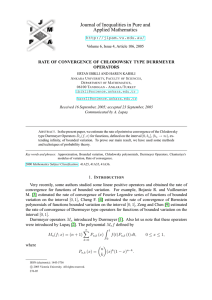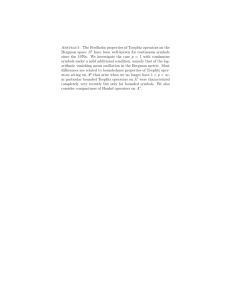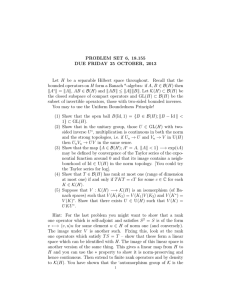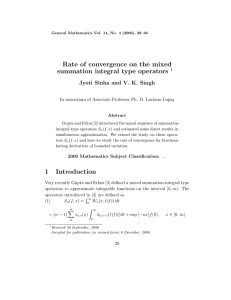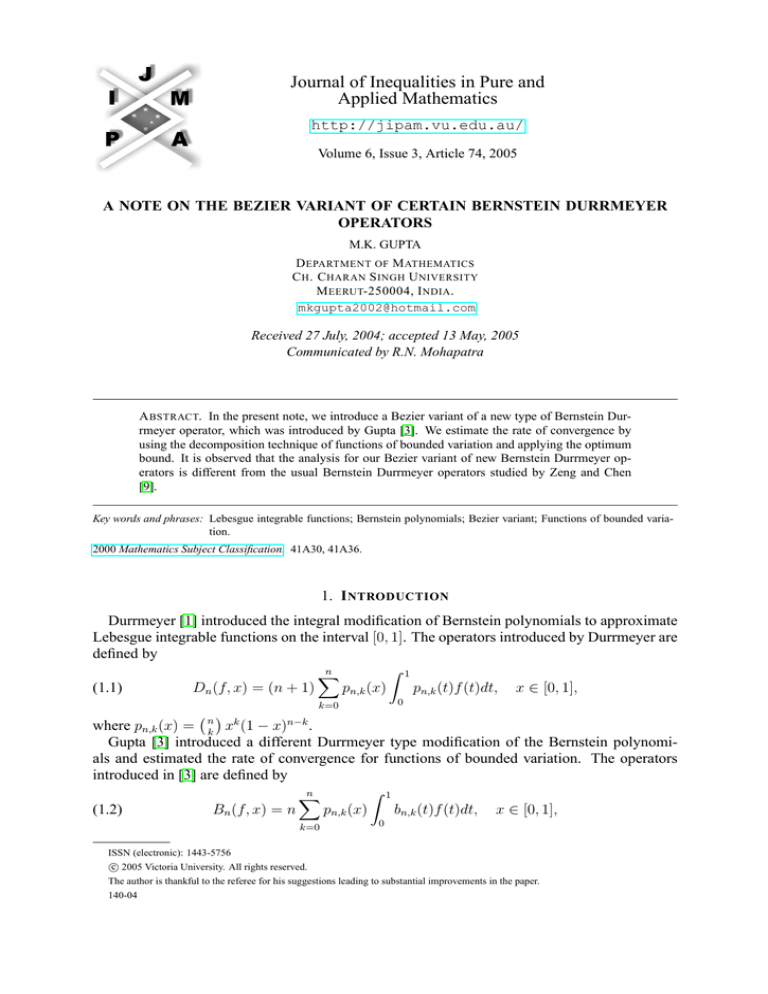
Journal of Inequalities in Pure and
Applied Mathematics
http://jipam.vu.edu.au/
Volume 6, Issue 3, Article 74, 2005
A NOTE ON THE BEZIER VARIANT OF CERTAIN BERNSTEIN DURRMEYER
OPERATORS
M.K. GUPTA
D EPARTMENT OF M ATHEMATICS
C H . C HARAN S INGH U NIVERSITY
M EERUT-250004, I NDIA .
mkgupta2002@hotmail.com
Received 27 July, 2004; accepted 13 May, 2005
Communicated by R.N. Mohapatra
A BSTRACT. In the present note, we introduce a Bezier variant of a new type of Bernstein Durrmeyer operator, which was introduced by Gupta [3]. We estimate the rate of convergence by
using the decomposition technique of functions of bounded variation and applying the optimum
bound. It is observed that the analysis for our Bezier variant of new Bernstein Durrmeyer operators is different from the usual Bernstein Durrmeyer operators studied by Zeng and Chen
[9].
Key words and phrases: Lebesgue integrable functions; Bernstein polynomials; Bezier variant; Functions of bounded variation.
2000 Mathematics Subject Classification. 41A30, 41A36.
1. I NTRODUCTION
Durrmeyer [1] introduced the integral modification of Bernstein polynomials to approximate
Lebesgue integrable functions on the interval [0, 1]. The operators introduced by Durrmeyer are
defined by
Z 1
n
X
(1.1)
Dn (f, x) = (n + 1)
pn,k (x)
pn,k (t)f (t)dt, x ∈ [0, 1],
0
k=0
n
where pn,k (x) = k xk (1 − x)n−k .
Gupta [3] introduced a different Durrmeyer type modification of the Bernstein polynomials and estimated the rate of convergence for functions of bounded variation. The operators
introduced in [3] are defined by
Z 1
n
X
(1.2)
Bn (f, x) = n
pn,k (x)
bn,k (t)f (t)dt, x ∈ [0, 1],
k=0
0
ISSN (electronic): 1443-5756
c 2005 Victoria University. All rights reserved.
The author is thankful to the referee for his suggestions leading to substantial improvements in the paper.
140-04
2
M.K. G UPTA
where
pn,k (x) = (−1)k
xk (k)
φ (x),
k! n
bn,k (t) = (−1)k+1
tk (k+1)
φ
(t)
k! n
and
φn (x) = (1 − x)n .
It is easily verified that the values of pn,k (x) used in (1.1) and (1.2) are same. Also it is easily
verified that
Z 1
n
X
pn,k (x) = 1,
bn,k (t)dt = 1 and bn,n (t) = 0.
0
k=0
By considering the integral modification of Bernstein polynomials in the form (1.2) some approximation properties become simpler in the analysis. So it is significant to study further on the
different integral modification of Bernstein polynomials introduced by Gupta [3]. For α ≥ 1,
we now define the Bezier variant of the operators (1.2), to approximate Lebesgue integrable
functions on the interval [0, 1] as
Z 1
n
X
(α)
(1.3)
Bn,α (f, x) =
Qn,k (x)
bn,k (t)f (t)dt, x ∈ [0, 1],
0
k=0
where
(α)
α
α
(x) − Jn,k+1
(x)
Qn,k (x) = Jn,k
and
Jn,k (x) =
n
X
pn,j (x),
j=k
when k ≤ n and 0 otherwise.
Some important properties of Jn,k (x) are as follows:
(i) Jn,k (x) − Jn,k+1 (x) = pn,k (x), k = 0, 1, 2, 3, . . . ;
0
(ii) Jn,k
(x) = npRn−1,k−1 (x), k = 1, 2, 3, . . . ;
x
(iii) Jn,k (x) = n 0 pn−1,k−1 (u)du, k = 1, 2, 3, . . . ;
(iv) Jn,0 (x) > Jn,1 (x) > Jn,2 (x) > · · · > Jn,n (x) > 0, 0 < x < 1.
For every natural number k, Jn,k (x) increases strictly from 0 to 1 on [0, 1].
Alternatively we may rewrite the operators (1.3) as
Z 1
Kn,α (x, t)f (t)dt, 0 ≤ x ≤ 1,
(1.4)
Bn,α (f, x) =
0
where
Kn,α (x, t) =
n
X
(α)
Qn,k (x)bn,k (t).
k=0
It is easily verified that Bn,α (f, x) are linear positive operators, Bn,α (1, x) = 1 and for α = 1,
the operators Bn,1 (f, x) ≡ Bn (f, x), i.e. the operators (1.3) reduce to the operators (1.2). For
(α)
further properties of Qn,k (x), we refer the readers to [3].
Guo [2] studied the rate of convergence for bounded variation functions for Bernstein Durrmeyer operators. Zeng and Chen [9] were the first to estimate the rate of convergence for
the Bezier variant of Bernstein Durrmeyer operators. Several other Bezier variants of some
summation-integral type operators were studied in [4], [6] and [8] etc. It is well-known that
Bezier basis functions play an important role in computer aided design. Moreover the recent
work on different Bernstein Bezier type operators motivated us to study further in this direction.
The advantage of the operators Bn,α (f, x) over the Bernstein Durrmeyer operators considered
J. Inequal. Pure and Appl. Math., 6(3) Art. 74, 2005
http://jipam.vu.edu.au/
B ERNSTEIN D URRMEYER O PERATORS
3
in [9] is that one does not require the results of the type Lemma 3 and Lemma 4 of [9]. Consequently some approximation formulae become simpler. Further for α = 1, these operators
provide improved estimates over the main results of [2] and [3]. In the present paper, we estimate the rate of point wise convergence of the operators Bn,α (f, x) at those points x ∈ (0, 1) at
which one sided limits f (x−) and f (x+) exist.
2. AUXILIARY R ESULTS
In this section we give certain results, which are necessary to prove the main result.
Lemma 2.1 ([3]). If n is sufficiently large, then
x(1 − x)
2x(1 − x)
≤ Bn ((t − x)2 , x) ≤
.
n
n
Lemma 2.2 ([4]). For every 0 ≤ k ≤ n, x ∈ (0, 1) and for all n ∈ N, we have
1
pn,k (x) ≤ p
2enx(1 − x)
.
Lemma 2.3. For all x ∈ (0, 1), there holds
α
(α)
Qn,k (x) ≤ α · pn,k (x) ≤ p
2enx(1 − x)
.
Proof. Using the well known inequality |aα − bα | ≤ α |a − b| , (0 ≤ a, b ≤ 1, α ≥ 1) and by
Lemma 2.2, we obtain
α
(α)
Qn,k (x) ≤ αpn,k (x) ≤ p
.
2enx(1 − x)
Lemma 2.4. Let x ∈ (0, 1) and Kn,α (x, t) be the kernel defined by (1.4). Then for n sufficiently
large, we have
Z y
2α · x(1 − x)
, 0 ≤ y < x,
(2.1)
λn,α (x, y) :=
Kn,α (x, t)dt ≤
n(x − y)2
0
and
Z
(2.2)
1
1 − λn,α (x, z) :=
Kn,α (x, t)dt ≤
z
Proof. We first prove (2.1), as follows
Z y
Z
Kn,α (x, t)dt ≤
0
y
Kn,α (x, t)
0
2α · x(1 − x)
,
n(z − x)2
x < z < 1.
(x − t)2
dt
(x − y)2
1
Bn,α ((t − x)2 , x)
(x − y)2
α · Bn,1 ((t − x)2 , x)
2α · x(1 − x)
≤
≤
,
2
(x − y)
n(x − y)2
≤
by Lemma 2.1. The proof of (2.2) is similar.
J. Inequal. Pure and Appl. Math., 6(3) Art. 74, 2005
http://jipam.vu.edu.au/
4
M.K. G UPTA
3. M AIN R ESULT
In this section we prove the following main theorem.
Theorem 3.1. Let f be a function of bounded variation on the interval [0, 1] and suppose α ≥ 1.
Then for every x ∈ (0, 1) and n sufficiently large, we have
1
α
Bn,α (f, x)−
f
(x+)
+
f
(x−)
α+1
α+1
√
/ k
n x+(1−x)
X
_
α
5α
(gx ),
≤p
|f (x+) − f (x−)| +
nx(1 − x) k=1
√
2enx(1 − x)
x−x/ k
where
f (t) − f (x−), for 0 ≤ t < x
0,
for t = x
gx (t) =
f (t) − f (x+), for x < t ≤ 1
and
Wb
a (gx )
is the total variation of gx on [a, b].
Proof. Clearly
(3.1) Bn,α (f, x) −
α
1
f (x+) +
f (x−) α+1
α+1
1 α − 1 |f (x+) − f (x−)| .
≤ |Bn,α (gx , x)| + Bn,α (sgn(t − x), x) +
2
α + 1
First, we have
Z
1
Bn,α (sgn(t − x), x) =
x
Z
Kn,α (x, t)dt −
x
Z
Kn,α (x, t)dt
0
1
Z
x
Kn,α (x, t)dt − 2
Kn,α (x, t)dt
0
Z x
Z 1
=1−2
Kn,α (x, t)dt = −1 + 2
Kn,α (x, t)dt.
=
0
0
x
Using Lemma 2.2, Lemma 2.3 and the fact that
k
X
j=0
Z
pn,j (x) =
1
bn,k (t)dt,
x
we have
Bn,α (sgn(t − x), x) = −1 + 2
n
X
(α)
Qn,k (x)
= −1 + 2
k=0
J. Inequal. Pure and Appl. Math., 6(3) Art. 74, 2005
1
bn,k (t)dt
x
k=0
n
X
Z
(α)
Qn,k (x)
k
X
pn,j (x)
j=0
http://jipam.vu.edu.au/
B ERNSTEIN D URRMEYER O PERATORS
= −1 + 2
n
X
pn,j (x)
j=0
= −1 + 2
n
X
5
n
X
(α)
Qn,k (x)
k=j
α
pn,j (x)Jn,j
(x).
j=0
Since
n
X
(α+1)
Qn,j
(x) = 1,
j=0
therefore we have
n
n
X
α−1
2 X (α+1)
α
Bn,α (sgn(t − x), x) +
=2
Q
(x).
pn,j (x)Jn,j (x) −
α+1
α + 1 j=0 n,j
j=0
By the mean value theorem, it follows
(α+1)
Qn,j
α+1
α+1
α
(x) = Jn,j
(x) − Jn,j+1
(x) = (α + 1)pn,j (x)γn,j
(x),
where
α
α
α
Jn,j+1
(x) < γn,j
(x) < Jn,j
(x).
Hence
n
X
α
−
1
α
α
≤2
Bn,α (sgn(t − x), x) +
pn,j (x)(Jn,j
(x) − γn,j
(x))
α+1
j=0
≤2
n
X
α
α
pn,j (x)(Jn,j
(x) − Jn,j+1
(x))
j=0
n
X
≤ 2α
p2n,j (x),
j=0
where we have used the inequality bα − aα < α(b − a), 0 ≤ a, b ≤ 1 and α ≥ 1. Applying
Lemma 2.2, we get
α − 1 2α
x ∈ (0, 1).
(3.2)
Bn,α (sgn(t − x), x) + α + 1 = p2enx(1 − x) ,
Next we estimate Bn,α (gx , x). By a Lebesgue-Stieltjes integral representation, we have
Z 1
(3.3)
Bn,α (gx , x) =
Kn,α (x, t)gx (t)dt
0
Z
Z
Z =
+
+
Kn,α (x, t)gx (t)dt
I1
I2
I3
= E1 + E2 + E3 ,
say,
√
√
√
√
where I1 = [0, x − x/ n] , I2 = [x − x /√n , x + (1 − x)/ n] and I3 = [x + (1 − x)/ n, 1].
We first estimate E1 . Writing y = x − x/ n and using Lebesgue-Stieltjes integration by parts,
we have
Z y
Z y
E1 =
gx (t)dt (λn,α (x, t)) = gx (y+)λn,α (x, y) −
λn,α (x, t)dt (gx (t)).
0
J. Inequal. Pure and Appl. Math., 6(3) Art. 74, 2005
0
http://jipam.vu.edu.au/
6
M.K. G UPTA
Since |gx (y+)| ≤
Wx
y+ (gx ),
|E1 | ≤
it follows that
x
_
y
Z
λn,α (x, t)dt −
(gx )λn,α (x, y) +
0
y+
x
_
!
(gx ) .
t
By using (2.1) of Lemma 2.4, we get
x
_
2α · x(1 − x) 2α · x(1 − x)
+
|E1 | ≤ (gx )
2
n(x
−
y)
n
y+
y
Z
0
!
x
_
1
dt − (gx ) .
(x − t)2
t
Integrating by parts the last term we have after simple computation
Wx
Z y Wx
2α · x(1 − x)
0 (gx )
t (gx )
|E1 | ≤
+2
dt .
3
n
x2
0 (x − t)
√
Now replacing the variable y in the last integral by x − x/ t, we obtain
x
n
x
n
x
X
_
X
_
2α(1 − x) _
4α
(3.4)
|E1 | ≤
(g
)
+
(g
)
≤
(gx ).
x
x
nx
nx(1
−
x)
√
√
0
k=1 x−x/ k
k=1 x−x/ k
Using a similar method and (2.2) of Lemma 2.4, we get
√
x+(1−x)/ k
n
X
_
4α
(gx ).
nx(1 − x) k=1
x
√
√
Finally we estimateE2 . For t ∈ [x − x/ n, x + (1 − x)/ n], we have
|E3 | ≤
(3.5)
√
x+(1−x)/ n
_
|gx (t)| = |gx (t) − gx (x)| ≤
(gx ),
√
x−x/ n
and therefore
√
x+(1−x)/ k
|E2 | ≤
_
Z
(gx )
x−x/ k
Rb
a
dt (λn,α (x, t))
√
x−x/ k
√
Since
√
x+(1−x)/ k
dt λn (x, t) ≤ 1, for all (a, b) ⊆ [0, 1], therefore
√
x+(1−x)/ n
_
|E2 | ≤
(3.6)
√
(gx ).
x−x/ n
Collecting the estimates (3.3) – (3.6), we have
(3.7)
|Bn,α (gx , x)| ≤
5α
nx(1 − x)
n
X
k=1
√
x+(1−x)/ k
_
(gx ).
√
x−x/ k
Combining the estimates of (3.1), (3.2) and (3.7), our theorem follows.
For α = 1, we obtain the following corollary, which is an improved estimate over the main
results of [2] and [3].
J. Inequal. Pure and Appl. Math., 6(3) Art. 74, 2005
http://jipam.vu.edu.au/
B ERNSTEIN D URRMEYER O PERATORS
7
Corollary 3.2. Let f be a function of bounded variation on the interval [0, 1]. Then for every
x ∈ (0, 1) and n sufficiently large, we have
Bn (f, x) − 1 [f (x+) + f (x−)]
2
√
/ k
n x+(1−x)
X
_
1
5
(gx ).
≤p
|f (x+) − f (x−)| +
nx(1 − x) k=1
√
2enx(1 − x)
x−x/ k
R EFERENCES
[1] J.L. DURRMEYER, Une formule d’inversion de la transformee de Laplace: Application a la Theorie
des Moments, These de 3e cycle, Faculte des Sciences de l’ Universite de Paris 1967.
[2] S. GUO, On the rate of convergence of Durrmeyer operator for function of bounded variation, J.
Approx. Theory, 51 (1987), 183–192.
[3] V. GUPTA, A note on the rate of convergence of Durrmeyer type operators for functions of bounded
variation, Soochow J. Math., 23(1) (1997), 115–118.
[4] V. GUPTA, Rate of convergence on Baskakov Beta Bezier operators for functions of bounded variation, Int. J. Math. and Math. Sci., 32(8) (2002), 471–479.
[5] V. GUPTA, Rate of approximation by new sequence of linear positive operators, Comput. Math.
Appl., 45(12) (2003), 1895–1904.
[6] V. GUPTA, Degree of approximation to function of bounded variation by Bezier variant of MKZ
operators, J. Math. Anal. Appl., 289(1) (2004), 292–300.
[7] X.M. ZENG, Bounds for Bernstein basis functions and Meyer- Konig- Zeller basis functions, J.
Math. Anal. Appl., 219 (1998), 364–376.
[8] X.M. ZENG, On the rate of convergence of the generalized Szasz type operators for functions of
bounded variation, J. Math. Anal. Appl., 226 (1998), 309–325.
[9] X.M. ZENG AND W. CHEN, On the rate of convergence of the generalized Durrmeyer type operators
for functions of bounded variation, J. Approx. Theory, 102 (2000), 1–12.
J. Inequal. Pure and Appl. Math., 6(3) Art. 74, 2005
http://jipam.vu.edu.au/


